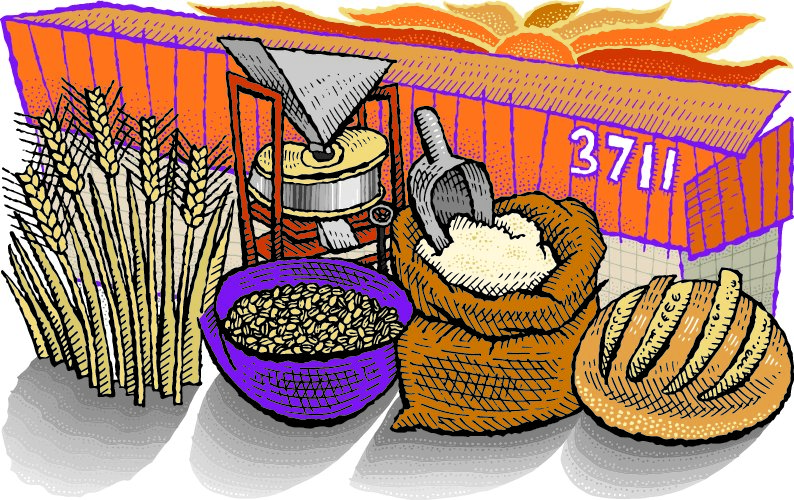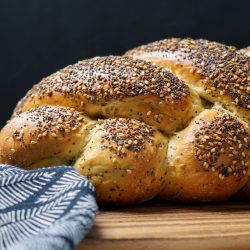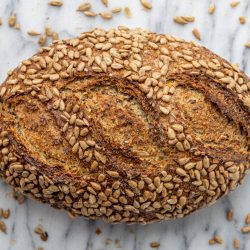For centuries, coarse, whole grain flours were the everyday norm for bread and porridge. White flours were a once-in-a-while treat for only the most special cakes or breads, reserved for the highest of holidays. As refined white flours became more readily available in the 20th century, Big Ag marketing departments promoted them by running a smear campaign against whole grains. Sure, the story went, the “nuts and twigs” diet of hippies was OK for healthy eaters, but not for anyone who wanted their foods to actually taste good.
 Boy did they get it wrong. For the past two years, a quiet revolution has been bubbling up at Zingerman’s Bakehouse. Thanks to a couple of granite millstones that now reside in Ann Arbor inside our bakery, the flavors, aromas, and textures of our baked goods have been getting a big boost. We’re now using freshly milled, whole grain flours in all of our brownies and cookies (as well as many of our breads). In the process, we’ve discovered a new stratosphere of flavor for these sweet treats.
Boy did they get it wrong. For the past two years, a quiet revolution has been bubbling up at Zingerman’s Bakehouse. Thanks to a couple of granite millstones that now reside in Ann Arbor inside our bakery, the flavors, aromas, and textures of our baked goods have been getting a big boost. We’re now using freshly milled, whole grain flours in all of our brownies and cookies (as well as many of our breads). In the process, we’ve discovered a new stratosphere of flavor for these sweet treats.
Good germs
The biggest advantage our granite mill gives is the ability to keep the grain’s germ intact and present in the flour. The germ is a tiny part of a grain, packed with precious nutrients and oils. Those oils are super flavorful—but also volatile. They go rancid over time. Industrial flour producers often remove the germ so the flour will keep for longer. What they gain in shelf life, they destroy in flavor and texture. Whole grain flours have a deep, toasty, wheat-y flavor that amplifies the flavor of pastries baked with it. Because we mill our flour just minutes before we bake with it, the shorter shelf life is a moot point.
More oil, more tender
The oil present in the germ makes for a softer, more tender texture for our pastries. It’s something you notice in the cookies, especially. They’re moist, almost fluffy, practically melting in your mouth. I’ve eaten a lot of Zingerman’s Bakehouse cookies in my day, tasting them as recipes have been tweaked, and this is the most noticeable improvement in texture I’ve ever experienced.

Local grain economies
Being local and knowing the provenance of your ingredients is a cornerstone of the modern food scene. Farmers markets have flourished, and many of us once again address our butcher by their first name. So why are local flours so hard to find? Unlike a fresh turnip or egg, grains must be transformed before we can use them. They must be milled. A century ago, practically every river, stream, brook, and creek anywhere near a town had a grain mill. Local farmers took their crops there for grinding. But as agricultural industrialization has pushed for the efficiencies of centralization, local mills shuttered. With them, flour went from being a product of the community to a faceless commodity. By installing our own mill, we’re turning back the clock. We now buy many grains directly from local farmers in Michigan and nearby states. In doing so, we gain more control of the quality of pastries and breads we bake.

A tighter loop
Milling some of our own grains in-house has highlighted another problem: it can be hard to find the grains you want, grown the way you want. We’ve forged relationships with local farmers willing to grow particular wheats and grains just for us. It’s a risk for both of us. We commit to buying all the crop, and the farmer does their best to grow the varieties we’re excited to bake with. Thanks to the close relationships we’re developing with local farms, we’re able to explore and experiment with different, sometimes tastier, grains. We’re not looking to reinvent the wheel (or cookie in this case), but if we can find a specific strain of wheat that can make a specific recipe just a little better, we want to do it.
This post was originally published on the Zingerman’s Mail Order blog, The Feed.


